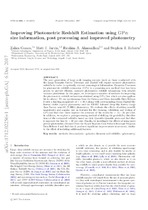| dc.contributor.author | Gomes, Zahra | |
| dc.contributor.author | Jarvis, Matt | |
| dc.contributor.author | Almosallam, Ibrahim A. | |
| dc.contributor.author | Roberts, Stephen J. | |
| dc.date.accessioned | 2018-02-15T08:41:28Z | |
| dc.date.available | 2018-02-15T08:41:28Z | |
| dc.date.issued | 2017 | |
| dc.identifier.citation | Gomes, Z. et al. (2017). Improving photometric redshift estimation using GPz: size information, post processing and improved photometry. Monthly Notices of the Royal Astronomical Society, 475(1): 331 - 342 | en_US |
| dc.identifier.issn | 0035-8711 | |
| dc.identifier.uri | http://dx.doi.org/10.1093/mnras/stx3187 | |
| dc.identifier.uri | http://hdl.handle.net/10566/3490 | |
| dc.description.abstract | The next generation of large-scale imaging surveys (such as those conducted with the Large Synoptic Survey Telescope and Euclid) will require accurate photometric redshifts in order to optimally extract cosmological information. Gaussian Process for photometric redshift estimation (GPZ) is a promising new method that has been proven to provide efficient, accurate photometric redshift estimations with reliable variance predictions. In this paper, we investigate a number of methods for improving the photometric redshift estimations obtained using GPZ (but which are also applicable to others). We use spectroscopy from the Galaxy and Mass Assembly Data Release 2 with a limiting magnitude of r < 19.4 along with corresponding Sloan Digital Sky Survey visible (ugriz) photometry and the UKIRT Infrared Deep Sky Survey Large Area Survey near-IR (YJHK) photometry. We evaluate the effects of adding near-IR magnitudes and angular size as features for the training, validation, and testing of GPZ and find that these improve the accuracy of the results by ~15–20 per cent. In addition, we explore a post-processing method of shifting the probability distributions of the estimated redshifts based on their Quantile–Quantile plots and find that it improves the bias by ~40 per cent. Finally, we investigate the effects of using more precise photometry obtained from the Hyper Suprime-Cam Subaru Strategic Program Data Release 1 and find that it produces significant improvements in accuracy, similar to the effect of including additional features. | en_US |
| dc.language.iso | en | en_US |
| dc.publisher | Oxford University Press | en_US |
| dc.rights | This is the pre-print version (from arXiv:1712.02256) of the article published online at: http://dx.doi.org/10.1093/mnras/stx3187 | |
| dc.subject | Methods | en_US |
| dc.subject | Data analysis | en_US |
| dc.subject | Galaxies | en_US |
| dc.subject | Distances | en_US |
| dc.subject | Redshifts | en_US |
| dc.subject | Photometry | en_US |
| dc.title | Improving photometric redshift estimation using GPz: size information, post processing and improved photometry | en_US |
| dc.type | Article | en_US |
| dc.privacy.showsubmitter | FALSE | |
| dc.status.ispeerreviewed | TRUE | |
| dc.description.accreditation | Scopus | |
| dc.description.accreditation | ISI | |

